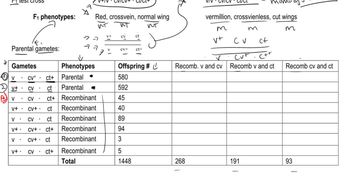In chickens, a condition referred to as 'creeper' exists whereby the bird has very short legs and wings and appears to be creeping when it walks. If creepers are bred to normal chickens, one-half of the offspring are normal and one-half are creepers. Creepers never breed true. If bred together, they yield two-thirds creepers and one-third normal. Propose an explanation for the inheritance of this condition.
Table of contents
- 1. Introduction to Genetics51m
- 2. Mendel's Laws of Inheritance3h 37m
- 3. Extensions to Mendelian Inheritance2h 41m
- 4. Genetic Mapping and Linkage2h 28m
- 5. Genetics of Bacteria and Viruses1h 21m
- 6. Chromosomal Variation1h 48m
- 7. DNA and Chromosome Structure56m
- 8. DNA Replication1h 10m
- 9. Mitosis and Meiosis1h 34m
- 10. Transcription1h 0m
- 11. Translation58m
- 12. Gene Regulation in Prokaryotes1h 19m
- 13. Gene Regulation in Eukaryotes44m
- 14. Genetic Control of Development44m
- 15. Genomes and Genomics1h 50m
- 16. Transposable Elements47m
- 17. Mutation, Repair, and Recombination1h 6m
- 18. Molecular Genetic Tools19m
- 19. Cancer Genetics29m
- 20. Quantitative Genetics1h 26m
- 21. Population Genetics50m
- 22. Evolutionary Genetics29m
2. Mendel's Laws of Inheritance
Monohybrid Cross
Problem 10d
Textbook Question
The dorsal pigment pattern of frogs can be either 'leopard' (white pigment between dark spots) or 'mottled' (pigment between spots appears mottled). The trait is controlled by an autosomal gene. Males and females are selected from pure-breeding populations, and a pair of reciprocal crosses is performed. The cross results are shown below.
Cross 1: P₁: Male leopard x male mottled
F₁: All mottled
F₂: 70 mottled, 22 leopard
Cross 2: P₁: Male mottled x female leopard
F₁: All mottled
F₂: 50 mottled, 18 leopard
Propose two different genetic crosses that would allow you to determine the genotype of one mottled frog from the F₂ generation.
 Verified step by step guidance
Verified step by step guidance1
Step 1: Understand the inheritance pattern. The problem states that the dorsal pigment pattern is controlled by an autosomal gene. The F₁ generation is all mottled, suggesting that mottled is dominant over leopard. The F₂ generation shows a ratio of mottled to leopard, which indicates Mendelian inheritance.
Step 2: Define the genotypes. Assign symbols to the alleles: 'M' for the dominant mottled allele and 'm' for the recessive leopard allele. A mottled frog could have the genotype MM (homozygous dominant) or Mm (heterozygous). A leopard frog would have the genotype mm (homozygous recessive).
Step 3: Design the first genetic cross. To determine the genotype of a mottled frog from the F₂ generation, cross the mottled frog with a homozygous recessive leopard frog (mm). If the mottled frog is heterozygous (Mm), the offspring will show a 1:1 ratio of mottled to leopard. If the mottled frog is homozygous dominant (MM), all offspring will be mottled.
Step 4: Design the second genetic cross. Alternatively, cross the mottled frog with another mottled frog from the F₂ generation. If both frogs are heterozygous (Mm), the offspring will show a 3:1 ratio of mottled to leopard. If one frog is homozygous dominant (MM) and the other is heterozygous (Mm), the offspring will show a 1:0 ratio of mottled to leopard.
Step 5: Analyze the offspring ratios. Based on the phenotypic ratios observed in the offspring from either cross, you can determine whether the mottled frog from the F₂ generation is homozygous dominant (MM) or heterozygous (Mm).
 Verified video answer for a similar problem:
Verified video answer for a similar problem:This video solution was recommended by our tutors as helpful for the problem above
Video duration:
2mPlay a video:
Was this helpful?
Key Concepts
Here are the essential concepts you must grasp in order to answer the question correctly.
Autosomal Inheritance
Autosomal inheritance refers to the transmission of genes located on the autosomes, which are the non-sex chromosomes. In this case, the dorsal pigment pattern of frogs is controlled by an autosomal gene, meaning that both males and females have two copies of the gene that can influence the trait. Understanding this concept is crucial for predicting the inheritance patterns and phenotypic ratios observed in the offspring.
Recommended video:
Guided course

Autosomal Pedigrees
Reciprocal Crosses
Reciprocal crosses involve mating individuals of different phenotypes in both possible combinations to determine the influence of parental genotypes on offspring traits. In the given scenario, the reciprocal crosses between leopard and mottled frogs help to establish whether the mottled phenotype is dominant over the leopard phenotype. Analyzing the results from these crosses aids in understanding the genetic basis of the observed traits.
Recommended video:
Guided course

Trihybrid Cross
Phenotypic Ratios
Phenotypic ratios represent the relative frequencies of different phenotypes in the offspring resulting from a genetic cross. In the F₂ generation of the crosses described, the observed ratios of mottled to leopard frogs provide insights into the underlying genotypes of the parents. By analyzing these ratios, one can infer the possible genotypes of the mottled frogs and design further crosses to confirm their genetic makeup.
Recommended video:
Guided course

Mutations and Phenotypes
Related Videos
Related Practice
Textbook Question
1317
views


